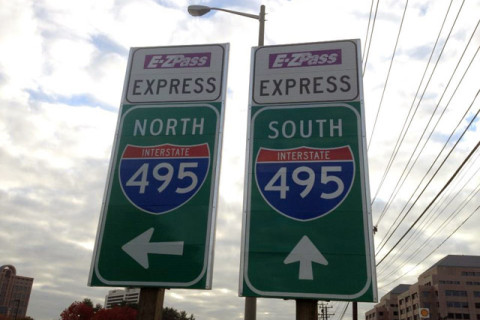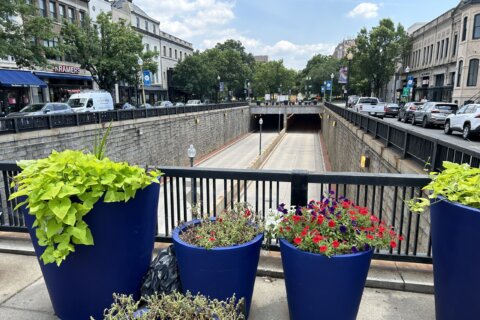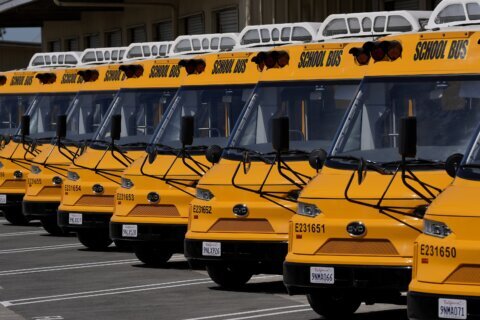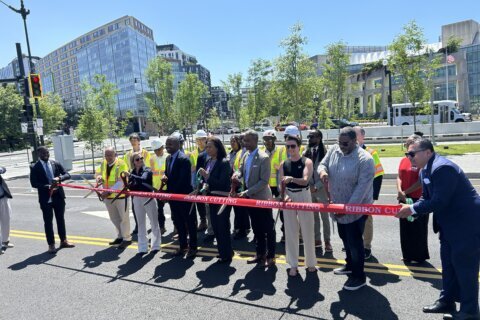Metro began its Better Bus program Sunday morning, it’s the biggest overhaul of the road-based transit system in 50 years.
Hundreds of bus routes, route names and times have changed.
“This is the first time in decades that we are making comprehensive changes to the bus,” said Metro General Manager Randy Clarke.
On Friday, D.C. Mayor Muriel Bowser and Clarke, along with city and transit agency staff members took a ride on the newly renamed D74 Potomac Park route that travels through four D.C. wards from the Rhode Island Avenue Metro Stop, winding its way through the city and eventually ending at the State Department in Foggy Bottom.
It’s a combination of several old familiar Metro bus routes: the H8, 42 and 43.
Clarke said this program took three years of staff work to complete and it creates an entirely new route-naming system, remakes and adds 7,000 new signs and consolidates more than 500 stops, some of which Metro said were just a few hundred yards from each other.
It also adds several new routes, including bus service between National Harbor in Prince George’s County and L’Enfant Plaza, as well as many others.
The system also has all-new route names, using regional letter prefixes for improved navigation. For example, routes with an “A” stand for Arlington/Alexandria, “M” are for Montgomery County, “D” is for downtown D.C. and “C” is for crosstown routes. “F” is for Fairfax City, Fairfax County, and Falls Church. Limited-stop routes are indicated by an “X” at the end of their names.
To help riders adjust to the new route names, Metro posted a musical aide on its X account.
An animated cartoon and accompanying song will have some riders of a certain age recalling how they learned about bills on Capitol Hill and the function of conjunctions.
The School House Rock-inspired cartoons explains how routes in Arlington and Alexandria begin with the letter “A” and D.C.’s crosstown buses start with a “C” while buses that run downtown will — you guessed it — start with the letter “D.”
“This is about providing people more reliable, more frequent, better bus service. We move over 400,000 people a day and we know it is a lifeline for people in our region to get to work, get to school, for health care and all of the great things this region has,” Clarke said at a news conference at Dupont Circle with the mayor, after the 25-minute bus ride through the city.
Clarke said there is also improved access to high-traffic locations, including malls, hospitals, supermarkets and transfer hubs in better coordination with the rail system, which helps to establish the bus system as the robust backbone of the region’s transportation system.
Area shifts led to system revamp
Both the mayor and Clarke said the bus system was due for an overhaul because the city and region has changed. Neighborhoods such as NOMA and Navy Yard either didn’t exist or were far less populated 40-plus years ago, and people who live in those communities now need reliable, affordable public transportation.
The mayor said this is a case of the transit agency changing to meet the needs of its customers.
“This redesign also give us more service, more frequency, more reliability for the same investment,” Bowser said. “We have a reliable system. A clean system. A safe system and an affordable system.”
The changes will also save Metro some money at a time when transit agencies across the country are just now beginning to see a recovery in ridership and in their financial books after the COVID-19 outbreak caused ridership and revenue to plunge.
“Metro is leading the U.S. in ridership growth; we now carry more people on our bus system them we did before the pandemic. We are the only large transit agency in the country that can say that,” Clarke said.
Clarke estimates the changes will save the transit agency at least $7 million a year. He acknowledges that until riders get used to the modifications, it may be a bit difficult to navigate the system. But he urges them to be patient and do some research before getting on a bus, and he believes in the long run the system will be more robust and reliable.
“This is about providing people with a more reliable, more frequent, better bus service. Not just during rush hour, but for people all days of the week, all hours of the day,” Clarke said.
Metro officials also worked closely with Montgomery County’s Ride On buses and Prince George’s County “The Bus” to try and coordinate schedule and route changes. Those two public transportation systems made adjustments on June 29 as well.
For more information on all of the changes to the bus system you can go to WTOP.com or https://www.wmata.com/initiatives/plans/Better-Bus/index.cfm
WTOP’s Kate Ryan contributed to this report.
Get breaking news and daily headlines delivered to your email inbox by signing up here.
© 2025 WTOP. All Rights Reserved. This website is not intended for users located within the European Economic Area.








